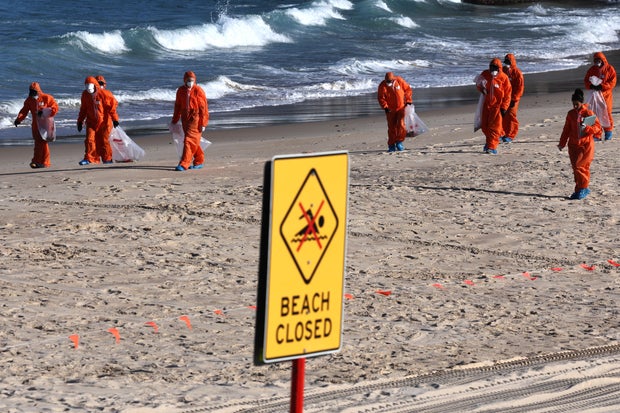Where plastic pollution ends up
Environmental officials in Australia still haven't completely solved the mystery of black balls found littering popular beaches on the country's eastern coastline, but they're getting closer. The New South Wales Environmental Protection Authority said Wednesday that the composition of the mysterious globs had been determined — and it's not pretty — but their origin remains unclear.
The golf-to-baseball sized balls — the appearance of hundreds of which forced the closure of two beaches near Sydney last month — are not, the agency said, tar balls as initially suspected. Or at least not simple tar balls from oil out at sea.
They're more likely to be sewage-trash balls.
According to the EPA's analysis, "the balls comprised fatty acids, petroleum hydrocarbons, and other organic and inorganic materials." In plain English, that means a mix of cooking oils and fats, cleaning and skincare products, hair, food waste, oil and gas and any number of other things that people routinely flush, dump or wash down drains and storm grates.
 Workers in protective suits conduct a cleanup operation to collect mysterious black balls that washed ashore on Coogee Beach in Sydney, Australia, Oct. 17, 2024.
DAVID GRAY/AFP/Getty
Workers in protective suits conduct a cleanup operation to collect mysterious black balls that washed ashore on Coogee Beach in Sydney, Australia, Oct. 17, 2024.
DAVID GRAY/AFP/Getty
"The investigation has revealed that the balls contain hundreds to thousands of different materials, including human hair and various fibres, indicating they likely originated from a source that releases mixed waste," the agency concluded.
But officials still couldn't say where the mix of materials came from.
The EPA said it looked at "several possible causes, such as a shipping spill or wastewater outflow," but that due to "the complex composition of the balls and the time they have spent in the water, testing has not been able to confirm their exact origin."
It said the regional water company, Sydney Water, reported "no issues with the operation or maintenance" at two nearby treatment facilities when asked soon after the balls appeared. A review of data by the state maritime meteorological agency yielded "nothing conclusive" about where they might have washed up from.
While the EPA said it was waiting for the final results of its tests on the mystery balls, the agency has separately been pushing for greater efforts to clean up the Sydney area, which it warned was quickly filling up with residents' trash.
"Greater Sydney is on the brink of a waste crisis, with landfill space expected to run out by 2030 unless urgent action is taken," the EPA said in a Nov. 1 social media post, heralding a Circular Economy Summit of government, industrial and environmental officials "to discuss the challenges and opportunities facing the NSW waste sector."
Officials explained that the concept of a circular economy is one that "keeps products and materials in use for as long as possible and reduces the need for new materials," to reduce the amount of waste sent to landfills — waste that, if it overwhelms the available landfill space, could be washed into water ways and then carried into the ocean.
The black balls first started showing up on the Coogee and Gordon's Bay beaches near Sydney in mid-October, the local mayor said at the time, suggesting they could be tar balls, which often form at sea after an oil spill or leak.
Authorities closed those beaches, along with Sydney's famed Bondi Beach and several others in the area, while cleanup operations continued. All the beaches were reopened after several days, based on authorities saying there were few or no more balls washing up, and a determination that they were "not highly toxic to humans."
- In:
- Oceans
- Hazardous Waste
- Wastewater
- Environmental Protection Agency
- Australia
- Environment
- Pollution
- Oil and Gas
Tucker Reals is CBSNews.com's foreign editor, based in the CBS News London bureau. He has worked for CBS News since 2006, prior to which he worked for The Associated Press in Washington, D.C., and London.











 English (US) ·
English (US) ·